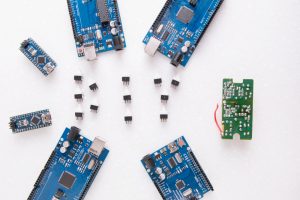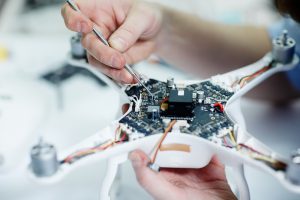[ad_1]
Experienced builders know their way around boards like the Arduino Uno, as well as smaller alternatives like the Arduino Nano or Adafruit Trinket. These open-source platforms can easily control local projects, but how do they stand up in more advanced applications?
We’ve seen tiny dev boards do big work: they enable devices to respond to remote signals and even transmit sensor data to the cloud. The seven dev boards we’ve outlined here are not only much smaller than the Arduino Uno – which has a 68.6 x 53.4mm footprint – but they feature built-in wireless communication options like Wi-Fi, Bluetooth, cellular, or even LoRa.
Arduino MKR1000
Development on what would become the now-ubiquitous Arduino Uno started in the early 2000s. It’s been around for a while, but Arduino hasn’t rested on its laurels; it’s busy producing updated innovations like the MKR1000.
This dev board features a SAMD21 Cortex-M0+ 32bit MCU, as well as the capability to communicate via WiFi using the 802.11 b/g/n specification.
While its 61.5 x 25mm footprint is quite small, the device packs in a LiPo battery charging circuit and connector along with its communication capabilities. The MKR1000 would be perfect for remote monitoring or control.
Pycom IoT Dev Boards
WiFi and Bluetooth technology have revolutionised how computers interact with distributed devices, but options like LoRa and cellular data are worth considering as well. Pycom’s current offerings all feature Bluetooth and WiFi capabilities, powered by an ESP32 module with a range of a kilometer or more.
Most of Pycom’s products also include other functions as well. For instance, the FiPy device can communicate with a whopping five different network types:
- Wi-Fi
- Bluetooth
- LoRa
- Sigfox,
- Dual LTE-M T
Pycom’s Wipy board features only Wi-Fi and Bluetooth and measures in at 42 x 20mm, while the others are 55 x 20mm.
Wemos D1 Mini
If Wi-Fi communication is your primary goal, a smaller and economical dev board will suit your needs perfectly. Look no further than the Wemos D1 mini.
The board is based on the ESP-8266EX WiFi module, giving it a clock speed of 80 or 160MHz, and it features a variety of IO pins with different functions. What sets this board apart is its price – it’s often available for around $3.
Along with its small – even for this list – size at 34.2 x 25.6mm, it’s a perfect candidate to hide away in a remote monitoring device or robot, especially if bumps or exposure to the elements might damage the device.
You can also choose from several accessories available using this board, expanding its abilities even further.
Adafruit Feather
Adafruit Feather dev boards hold a wide range of capabilities. The 32u4 Basic Proto, as the name suggests, is its most streamlined offering. The Basic Pronto doesn’t come with any built-in communications, but Adafruit Feather’s other boards include features like:
- ESP32 module for WiFi/Bluetooth
- ESP8266 module that only “speaks” WiFi
- Several types of LoRa radios
- FONA board that gives you access to cellular data
Each of these boards also features a LiPo charging circuit/connection, and you can choose additional shields and accessories to suit your application.
These boards have varying footprints, but they’re all in the 50 to 60 x 23mm range.
Particle
Particle claims to provide “everything to power your IoT product, from device to cloud,” and boasts itself as the most widely used IoT platform.
One of Particle’s most well-known products is the Particle Photon, which uses the same WiFi module found inside the Amazon Dash button, along with an STM32 ARM Cortex M3 microcontroller.
With a minuscule footprint of 36.6 x 20.3mm, this device still features a variety of GPIO pins, and purchasing one gives you access to Particle’s cloud service for your first 100 devices.
The company has optimized its newest modules for mesh networking, and each one features LiPo charging. They even fit the Adafruit Feather form factor, allowing you to use Adafruit Feather’s FeatherWing accessories in a Particle-based application.
Raspberry Pi Zero W
You might argue that the “PZW” doesn’t belong on this list of dev boards. Yes, it’s a single-board computer, but it features the same 40-pin GPIO setup as the standard Raspberry Pi.
The PZW also includes Bluetooth and WiFi connectivity, meaning users can monitor or control physical events at a distance.
It’s also about half the size of the Arduino Uno, with a footprint of 65mm x 30mm. At a list price of $10, it would be a shame to leave this device off the list, especially since it has one crucial bonus feature: users can opt to interact with the computer using a screen, mouse, or keyboard.
Espurino
The smallest board on this list comes with a 30 x 23mm footprint. The Espurino WiFi may be tiny, but it still features an impressive 21 GPIO pins, a 32-bit STM ARM Cortex processor running at 100MHz, and an ESP8266 WiFi module for communication.
One big difference between the Espurina and other dev boards has to do with programming: instead of programming the board on your computer, then transferring the program to the device, you program the device directly. The user does this by either entering commands via a terminal program or through a Chrome web app via a USB connection.
Its roughly $40 price tag may turn off some budget-conscious hackers, but impressive specs and a unique interface make it an option worth considering.
Your own IoT solution
Wireless networking was barely entering the mainstream when the Arduino Uno debuted, so it’s impressive to see how the technology has advanced in price and size. There’s never been an easier time to develop your own miniature IoT solution.
Jeremy S. Cook is an engineer who has worked in manufacturing automation and writes for a variety of technical publications. Zach Wendt is a mechanical engineer with a background in consumer product development. He works for Arrow Electronics, a major supplier of Arduino products.
[ad_2]
Source link


